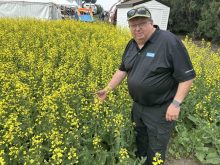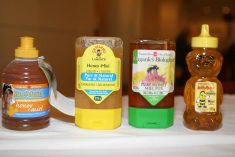The lawyer for Bruno, Sask., farmer Percy Schmeiser says the judge who
determined Schmeiser was guilty of violating Monsanto’s Roundup Ready
patent made 17 fundamental errors in his decision.
Terry Zakreski outlined those errors in front of three Federal Court of
Appeal justices last week. But his case boiled down to two key points –
the fact that Schmeiser never sprayed his 1998 canola crop with Roundup
and the claim that Monsanto violated Schmeiser’s property rights by
seizing the farmer’s seed.
Read Also

First annual Ag in Motion Junior Cattle Show kicks off with a bang
Ag in Motion 2025 had its first annual junior cattle show on July 15. The show hosted more than 20…
Schmeiser was found guilty of growing Roundup Ready canola without a
licence by a Federal Court of Canada judge during a widely publicized
trial last year. A few months after justice Andrew MacKay’s March 29,
2001, decision Schmeiser filed an appeal. That appeal was heard last
week in a Saskatoon courtroom.
Zakreski told the appeal court that three key facts came out in the
original trial. The trial judge said there was no evidence that
Schmeiser had purchased any brown bag seed or that he had segregated
any of the Roundup Ready canola found in his fields. But the
“coup-de-grace” was that the trial judge determined the farmer did not
spray his 1998 canola crop with Roundup.
MacKay ruled that growing the Roundup Ready canola, harvesting it and
selling it to a crushing plant constituted using the invention without
permission. But Zakreski argued that Schmeiser would have to spray the
crop with Roundup to use the invention.
“(MacKay) misconstrued the patent by saying that we don’t need to
spray.”
In his response, Monsanto’s lead lawyer Roger Hughes said the trial
judge made no errors. He said Schmeiser grew the genetically modified
crop and sold it.
“That’s use. Even the Oxford Dictionary agrees with me on that,” said
Hughes.
He said there is nothing in Monsanto’s patent claims that says a farmer
must spray Roundup to infringe the patent and cited previous decisions
that came to a similar conclusion. He also came up with an example of
his own.
“If I have a bulletproof vest, do I first have to take a bullet to
infringe it?”
The other main point raised by Zakreski during the appeal was that if
genetically modified canola pollen drifts onto a farmer’s land, it
should become the property of the farmer.
“The judge says it doesn’t matter how it gets on your land and we say
it does. That is crucial,” said Zakreski.
He called what happened in the Schmeiser case “conscripted patent
infringement” and said it was an “unfair burden” for a farmer to have
to prove where his crop came from.
Later in the appeal he argued that Schmeiser’s right not to be
subjected to unreasonable search and seizure was violated when
Monsanto’s private investigators obtained some of the seed Schmeiser
had taken to Humboldt Flour Mills.
Justice Julius Isaac told Zakreski that he wasn’t going to be convinced
that any of Schmeiser’s rights and freedoms guaranteed under the
charter had been violated.
“Go ahead and make it, but it’s not your best point,” he said.
During his response, Hughes said that Zakreski’s charter arguments were
not valid and should not be used in such a case.
“We are here to interpret a patent case,” said the lawyer.
He said the GM canola did not drift onto Schmeiser’s property, but was
knowingly planted by the farmer in 1998. Schmeiser testified that he
used seed from the 1997 fields where he had discovered Roundup Ready
plants to seed 1,030 acres of canola in 1998.
“He had an opportunity to use some other seed in some other bin but
what did he do? He used this seed,” Hughes told the three justices.
Hughes said Monsanto had a court order to obtain samples of Schmeiser’s
crop, so even if the Humboldt Flour Mills evidence was disallowed,
there are other samples that show the concentration of Roundup Ready
canola in Schmeiser’s fields was 95 percent.

















